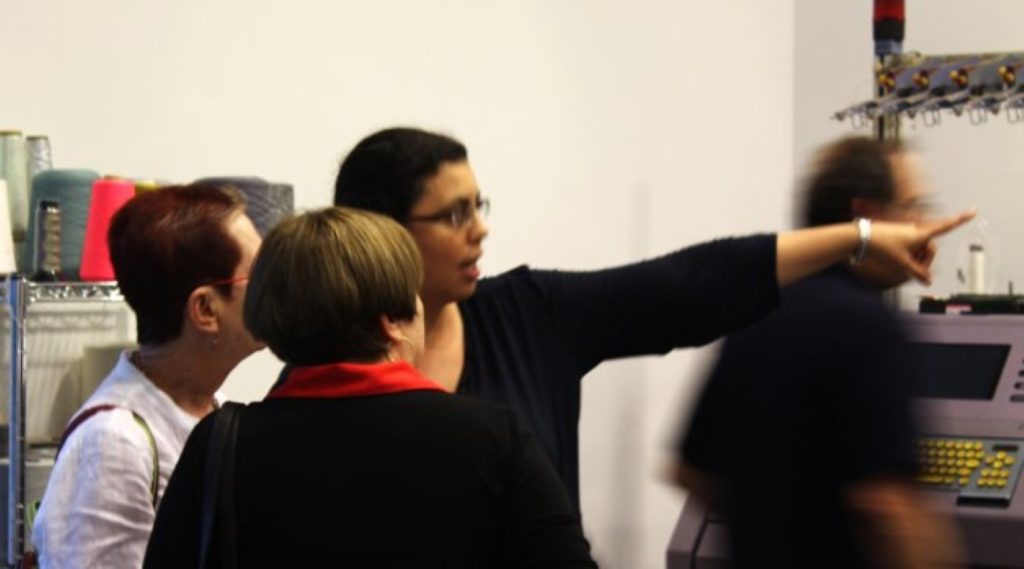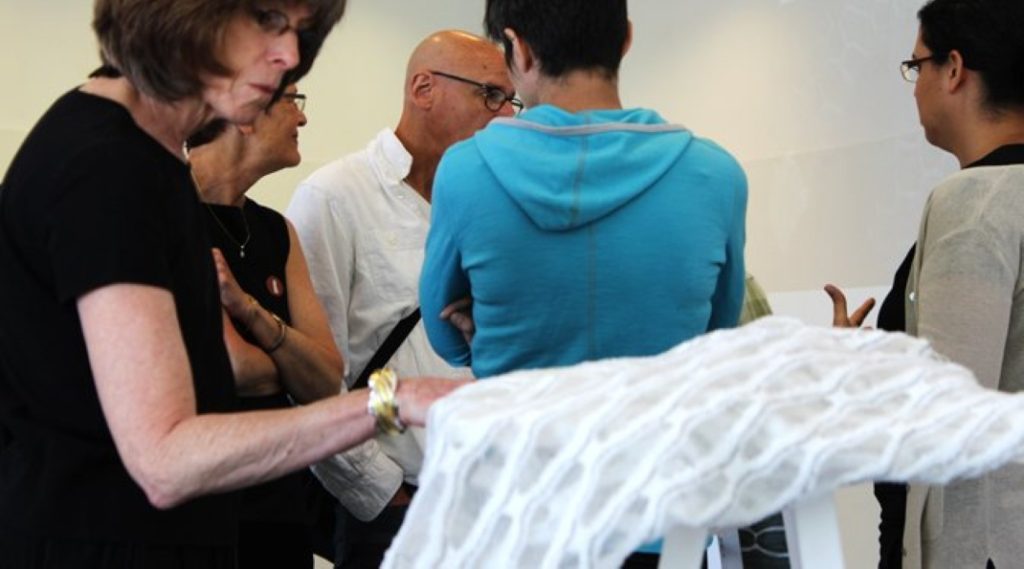What happens when a material is part of the design process itself? The process of creating fabric using a computerized industrial knitting machine will be visible to visitors at the
What happens when material is part of the design process itself?The Design Lab is hosting architect Ayelet Carmon from Shenkar College of Engineering and Design and Prof. Mette Ramsgard Thomsen from Denmark in a project in which smart textile surfaces are created. The process of creating fabric using a computerized industrial knitting machine will be visible to visitors at the Lab.

What are two architects doing in the world of textile?
Carmon and Ramsgard Thomsen became acquainted at a workshop held at Shenkar, which architect Eyal Nir, a mutual colleague, invited Ramsgard Thomsen to attend. The two architects in the world of textile decided to join forces to create and investigate a world of smart textiles. They knit, study, and develop these textiles, and hope that the technology they’re working on will open new opportunities for the world of computerized architecture.

What do they create?The project engages in smart textiles from a research-design perspective. They develop a site-specific material; in other words, rather than taking existing materials and using them to create something new in an existing setting, Carmon and Ramsgard Thomsen aim to create material that is adapted to the setting in which it is going to be used or located. According to the two architects, although this is not a new idea, it has only recently become feasible by means of computerized production and digital tools developed in recent years, and which have become relatively accessible to designers and creators due to the power of computers and sophisticated software.

Knitted textile embedded with a light sensorHow did it all begin?In the 1980s, new machinery and technology were introduced into the textile industry. However, real interest in advanced textile technologies only began following an exhibition curated by Matilda McQuaid at Cooper-Hewitt, entitled Extreme Textiles, where she presented textiles that were unlike those that had customarily been presented until then. She focused on types of rope, and examined textiles for the defence industries and medical uses. McQuaid presented where textile design enters the industrial world, and revolutionized the way the world perceives textile design. She demonstrated how developing smart textiles can save lives, replace existing materials, and change the way we react to fabric and how it reacts to us. The exhibition sparked the imagination of the design world, and textile became a ‘hot issue’. Today, given our increasing preoccupation with sustainability, textile has become relevant and meaningful in the design discourse. The whole digital-textile sphere is developing at an impressive rate, and although computerization and technologies are relatively new in the world of textile, the challenge is to see how innovative elements can be combined with the traditional tools of the worlds of textile and architecture to create something new.

How does material design become part of space design?
Their interest in textile was aroused then they explored the notion whereby an architect can be not only the creator of a design, but also the creator of the material itself from which he will design his work. Nowadays, the role of the architect invariably ends when he completes the design of the building, and he uses existing fabrics and readymade materials to design the interior. In the past decade we have entered an era in which virtually all the materials around us are engineered, namely materials created for specific purposes. This is true of the construction industry as well; many products have been engineered for the convenience of the consumer and to meet his needs. But this convenience and these needs are general, they do not enable each individual to change and adapt them to his particular and unique space. Consequently, Carmon and Ramsgard Thomsen decided to examine what happens when the process of designing materials becomes a tangible part of designing space and atmosphere.

How is this expressed in the Design Lab?They examine how sensors can be embedded into the material, and how the sensors can be interfaced with digital manufacturing. In the Lab space they are knitting a curtain prototype that will contain sensors that collect information from the environment. This information will influence the development of the next curtain, which will be more suited to the specific space where it hangs. It is a process in which the design is created as information is gradually collected.

What can one see there today?The curtain currently comprises a transparent base layer with knitted ‘sails’ of varying materiality and color growing from it. The sensors are knitted into this fabric and collect information on everything that goes on around them. Their first prototype is very simple and basic, and as they collect more and more information, they are already developing the pattern for the next knitting according to the results they have obtained from the sensors. The textile they create is a new fabric that is dependent upon numerous factors, there is a huge variety of fibers and knitting possibilities and even with the same fiber, there are a variety of techniques, each of which produces a different result. It is a conversation between the logic of the material – how it reacts, what it can be combined with, and so forth – and digital logic – how can the different designs obtained from the vast information be combined, and what can actually be programmed and coded. For the two architects, textile design is in effect the creation and design of material. Visitors can come into the Lab and see how the curtain project is progressing, as well as past projects that developed and constituted the building blocks for the current project. Visitors can touch the textiles with conductive sensors that record the hand’s location, see fabric that reacts to water and dissolves in humidity, and fabric with a pattern designed according to information obtained by human touch, in which each element comprising the pattern is unique.

The project is done in collaboration with: Anna Gitelson Kahn- textile designer, Gabi Kertes- knitting technician and .Yaniv Baranes- interior designer, photography, design and production, Nir Zeevi- interior designer, design and production, Amir Marcovitz- interactive and electronics, Dr. Eyal Sheffer- Shenkar Prof. textile engineer, Mette Ramsgard Thomsen, CITA, Centre for IT and Architecture, Royal Danish Academy of Fine Arts, School of Architecture.
The project is dedicated to the memory of Ami Cang
Acknowledgments: with thanks to Shenkar College of Engineering and Design for supporting this research through the funding of the “Rapaport Award for Creativity and Innovation”.

